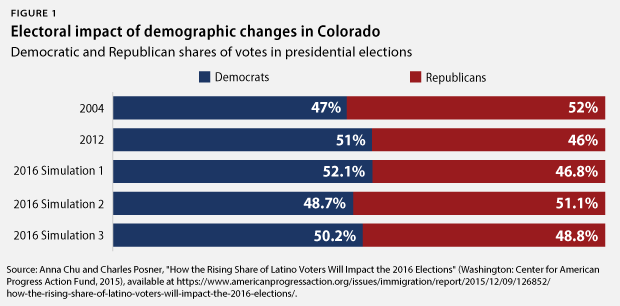See also:
The United States is undergoing a historic demographic shift. People of color are expected to make up a majority of the population by 2044, but the political implications are already being felt. By 2016, demographic shifts will be influential in shaping electoral outcomes in many states, including Colorado, as voters of color become an increasingly significant share of the electorate.
Moreover, DAPA-affected voters—U.S. citizens of voting age living with unauthorized family members who would be eligible for temporary relief from deportation under President Barack Obama’s Deferred Action for Parents of Americans and Lawful Permanent Residents, or DAPA, program—will comprise sizable and potentially decisive portions of key and emerging battleground state electorates across the country, including in Colorado.
The electoral impacts of a changing electorate
In Colorado, Latino voters comprise a larger portion of the electorate each year
- The Latino population has grown rapidly—from 9 percent in 1980 to 22 percent in 2014—and is projected to reach 40 percent by 2060. The Latino share of eligible voters has doubled from 8 percent in 1980 to 16 percent in 2014 and is projected to reach 37 percent by 2060.
- If the Latino vote share sees the same growth as projected for the share of Latino eligible voters, in 2016, 15.6 percent of voters will be Latino for the first time ever, up from 14 percent in 2012.
Colorado’s changing demographics are making it lean more toward Democrats—but it is still a toss-up
- In 2004, Democratic presidential candidate John Kerry had a 38-percentage-point advantage over Republican candidate George W. Bush among Latino voters, leading 68 percent to 30 percent. In 2012, Democratic candidate Barack Obama won 75 percent of Latino votes while Republican Mitt Romney received 23 percent, a 48-point margin.
- If Democrats are able to hold onto 2012 levels of support from voters of color and turnout rates remain the same in 2016 (see Figure 1, 2016 Simulation 1), the Democratic margin of victory in Colorado could be more than 5 percentage points, yielding a Democratic victory of 52.1 percent to Republicans’ 46.8 percent in the presidential election.
- If voters’ party preferences reverted back to what they were in 2004 (see Figure 1, 2016 Simulation 2), when Republicans had higher levels of support from voters of color, Republicans would see the presidential race in Colorado swing in their favor, winning by 51.1 percent to 48.7 percent.
- White voters will still play a critical role in Colorado: If voters of color have party preferences of 2004 but white voters have party preferences of 2012 (see Figure 1, 2016 Simulation 3), Democrats would win by a narrow 1.4-percentage-point margin.

The political power of deferred action
In addition to the overall demographic shifts in Colorado, DAPA-affected voters comprise a significant proportion of the state’s electorate
- In 2016, Colorado voters who are personally affected by DAPA will number more than 21,000. The projected number of Colorado’s DAPA-affected voters in 2016 equals 15 percent of President Obama’s 2012 margin of victory in the state.
Full implementation of the deferred action initiatives would result in significant economic gains for Colorado
- If DAPA; Deferred Action for Childhood Arrivals, or DACA; and DACA expansion were all implemented, Colorado’s gross domestic product would increase by $3.3 billion; Colorado residents’ cumulative incomes would increase by $2.1 billion; and more than 4,000 jobs would be created, all cumulatively over 10 years.
Charles Posner is the Policy Manager at the Center for American Progress Action Fund. Lizet Ocampo is the Associate Director of Immigration at the Action Fund.